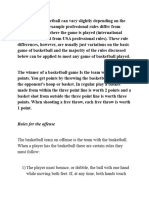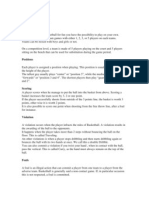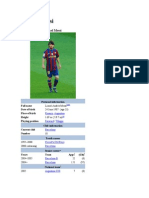P.E 4
P.E 4
Uploaded by
Mira Depositario SultonesCopyright:
Available Formats
P.E 4
P.E 4
Uploaded by
Mira Depositario SultonesCopyright
Available Formats
Share this document
Did you find this document useful?
Is this content inappropriate?
Copyright:
Available Formats
P.E 4
P.E 4
Uploaded by
Mira Depositario SultonesCopyright:
Available Formats
Basic Basketball rules Number of players If you want to play basketball for fun, you have the possibility
of playing on your own. But you can also play team games with either 1, 2, 3, 4 or 5 players on each teams. Teams can be mixed, with boys and girls, or not. On a competition level, a team is made up of 5 players playing on the court and 5 players sitting on the bench that can be used for substitution during the whole period of the game. Positions Each player is assigned a position when playing. This position is usually determined by the height of the player. The tallest player on the team usually plays center also known as position 5, while the medium size ones play forwards / position 3 and 4. The shortest players then play guards / position 1 and 2. Scoring A player scores when he manages to throw the ball into the basket, with the ball passing through the basket from above the hoop. Scoring a basket increases the teams score by 3, 2 or one point. If the player successfully shoots from outside of the 3 points line, the basket is worth 3 points; otherwise it is worth 2 points. It is also possible to score one point when shooting from the free throw line, after a foul for instance. Violation A violation occurs when the player breaks one of the rules of Basketball. A violation results in the awarding of the ball to the opponents. It can also result from the player taking more than 2 steps without bouncing the ball on the floor. This is called Traveling. Another example of violation occurs when a player stops dribbling and then starts dribbling again or when he bounces the ball with both hands on the ball. We call this a double Dribble. A violation is also committed if you twist your hand, when in contact with the ball, beyond the vertical, bringing it under the ball. This is called Carry, as the hand must always remain on the top of the ball. Fouls A foul is an illegal action that can be committed by player from one team against a player from the opposing team. Basketball is generally said to be a non-contact game. If contact occurs beyond what is deemed to be reasonable, or if a player thereby obtains an unfair advantage from it, a foul is committed. There are two types of fouls. The first are called defensive fouls. They occur when the offensive player is being fouled by the defender. Defenders should not block, push, trip, strike or hold the player in possession of the ball. The second ones are the offensive fouls. For example, a player in offence commits a foul when charging into a stationary defender.
Referee signals
Administrative signals
Scoring signals
Violation signals
HISTORY & NATURE OF THE GAME Basketball was invented in 1891 by James Naismith; a Canadian teacher. It was rst played with a soccer-style ball and peach baskets as the goals. Basketball is a team sport in which two teams of ve players on the court (usually 2 guards, 2 forwards and 1 centre) each try to score points against one another by forcing a ball through a 10 feet (3m) high hoop. The ball can be advanced on the court by dribbling or passing it between teammates. Disruptive physical contact (fouls) is not permitted and there are restrictions on how the ball can be handled (violations). The nature of the game of Basketball is to try to score more points than the opposing team by throwing - or 'shooting' - a ball through the opening in the top of the basketball hoop, whilst following a set of rules. Whichever team has the most points at the end of the game wins, although additional time may be issued in the rare instance that a game ends in a tie. It is one of the world's most popular a widely enjoyed sports. The hoop that the players must try to shoot their basketballs through is, by regulation, 18 inches in diameter at the rim and mounted to a backboard 10 feet off the ground. During regular play, either team can score a 'field goal' by shooting the basketball through the hoop. This will score then respective teams two points, due to the distance the player will be from the hoop. The 'easiness' of scoring a basket whilst touching or closer to the hoop than the three-point line means a score of two points is possible, while being on or behind the three-point line, as its name suggests, awards the player an extra point (three) for the technicality of their shots. Movement while in control of the ball is governed by a 'dribbling' technique, where the basketball is bounced by the player as they are walking or running, and team mates can also pass the ball to other players on their team in a variety of ways. It is a direct violation of the rules to walk with the ball, carry it, or double dribble, which means to hold the ball after dribbling, and then resume dribbling. Violating the rules in such a way will result in a 'foul'. Other ways a player can earn a foul include engaging in disruptive physical contact (Basketball is primarily a non-contact sport). If an offensive player is fouled upon while shooting, he is usually awarded a free throw from which two points can be scored. 'Technical' fouls exist too, and these are usually issued when certain indiscretions occur. These most commonly include unsportsmanlike conduct on the part of a player or a coach, and can also result in a free throw for the opposing team. Basketball has its own sets of commonly used techniques of ball control such as passing, dribbling and shooting, and has also evolved very many specialized player positioning techniques and offensive/defensive structures. The tallest members of a Basketball team will typically play the 'power forward', 'center' or 'small forward positions', whereas shorter players and more technically minded players may be consigned to the 'shooting guard' or 'point guard' positions. Competitive basketball is carefully regulated by, but in light of this, a whole host of variations on 'traditional' Basketball have been developed for more casual play. Competitive basketball is usually
played indoors on well maintained and perfectly marked out courts, but the less regulated versions of the game can be seen to be played outdoors in a variety or urban and rural areas alike.
Outside the three-point arc Shots scored from outside of the three-point line - the D-shaped arc surrounding each team's basket earn three points. The shooter must have at both feet on the floor outside the three-point line prior to the attempt. Three-point shooting is highly prized by teams and spectators alike, especially if the winning basket is hit from distance on the buzzer. Inside the three-point arc Shots which find the basket from inside of the three-point line are worth two points. An unsuccessful free throw attempt which is tapped into the basket also counts as two points. Free throws A free throw is an unchallenged shot at the basket from the free-throw line, taken while the clock is stopped. They are worth one point. They are awarded after a technical foul a personal foul on a player in the act of shooting or a personal foul after the team committing the foul has exceeded four fouls in that quarter. The number awarded (1-3) depends on the offence. If a player scores despite being fouled, he also gets free throws.
You might also like
- The Rules: Breakthrough Bonus: Download The "Basketball Basics" Article As A FREE PDF! (Document5 pagesThe Rules: Breakthrough Bonus: Download The "Basketball Basics" Article As A FREE PDF! (Cleo VillanuevaNo ratings yet
- BasketballDocument3 pagesBasketballapi-145517234No ratings yet
- Physical Education Lesson 4 (Basketball)Document26 pagesPhysical Education Lesson 4 (Basketball)Rheanna BaquillerNo ratings yet
- BASKETBALL-ASSDocument1 pageBASKETBALL-ASSDalen BayogbogNo ratings yet
- Basketball Rules & RegulationsDocument6 pagesBasketball Rules & Regulationsnileshsojitra108No ratings yet
- Nature and Background of Basketball-LECTUREDocument5 pagesNature and Background of Basketball-LECTUREMa Jean PatulayinNo ratings yet
- BasketballDocument4 pagesBasketballGaurav GuptaNo ratings yet
- UD295Document3 pagesUD295moyeso4250No ratings yet
- Rules and Regulations For BasketballDocument10 pagesRules and Regulations For Basketballjiggtyler6No ratings yet
- Basketball Is A: From Wikipedia, The Free EncyclopediaDocument1 pageBasketball Is A: From Wikipedia, The Free EncyclopediaLGCPNo ratings yet
- Basketball HistoryDocument1 pageBasketball HistoryLilibeth SalvosaNo ratings yet
- Basic Basketball Rules: Number of PlayersDocument3 pagesBasic Basketball Rules: Number of PlayersAthena RoseNo ratings yet
- Basketball RulesDocument7 pagesBasketball RulesPETERNo ratings yet
- BasketballDocument24 pagesBasketballnyi waaaah rahNo ratings yet
- Basketball Activity PrepDocument6 pagesBasketball Activity Prepapi-3029416560% (1)
- FREE! Get 72 of Our and 32 of Our .: Favorite Basketball Drills Favorite Basketball PlaysDocument5 pagesFREE! Get 72 of Our and 32 of Our .: Favorite Basketball Drills Favorite Basketball PlaysSyra Mae NevarezNo ratings yet
- Basic Basketball RulesDocument3 pagesBasic Basketball Ruleshadie06No ratings yet
- bball_ (1)Document4 pagesbball_ (1)50073764No ratings yet
- BasketballDocument4 pagesBasketballInnocent GraceNo ratings yet
- Basketball Is A Sport Played by Two Teams of Five Players On A Rectangular CourtDocument4 pagesBasketball Is A Sport Played by Two Teams of Five Players On A Rectangular CourtKirti BhadangeNo ratings yet
- Presentasi Bahasa Inggris Describing BasketballDocument4 pagesPresentasi Bahasa Inggris Describing BasketballElang IhzaNo ratings yet
- PEAHM 117 Team Sport (Basketball) : - Rules and Regulations - Responsibilities of Officials - Hand SignalsDocument7 pagesPEAHM 117 Team Sport (Basketball) : - Rules and Regulations - Responsibilities of Officials - Hand SignalsHanna Relator DolorNo ratings yet
- Fundamentals of BasketballDocument4 pagesFundamentals of BasketballGerson Baclao100% (1)
- Basketball Is A: Playing RegulationsDocument4 pagesBasketball Is A: Playing RegulationsMichz AlfaroNo ratings yet
- Basketball Fundamentals ReadyDocument17 pagesBasketball Fundamentals ReadyArriene Chris Ocho DiongsonNo ratings yet
- Basketball Print Out TodayDocument27 pagesBasketball Print Out Todaymaryislit2377No ratings yet
- BasketballDocument1 pageBasketballChristian Bohorquez JimenezNo ratings yet
- Start of PlayDocument5 pagesStart of PlaynicNo ratings yet
- BASKETBALL Hand OutDocument6 pagesBASKETBALL Hand OutTrisha MenesesNo ratings yet
- Rules: Gerald Jun P. Gavarra BSED Major in Science 1-A William Vincent F. Gogolin Major in Science 1-ADocument6 pagesRules: Gerald Jun P. Gavarra BSED Major in Science 1-A William Vincent F. Gogolin Major in Science 1-AIvy Base - LaraNo ratings yet
- Basketball: Basketball Is A Team Sport in Which Two Teams, Most Commonly of FiveDocument10 pagesBasketball: Basketball Is A Team Sport in Which Two Teams, Most Commonly of FiveDebo ChakrabortyNo ratings yet
- Violations: Basketball Is ADocument4 pagesViolations: Basketball Is ATannu DaralNo ratings yet
- Description and Brief History of Basketball SportsgooglyDocument4 pagesDescription and Brief History of Basketball SportsgooglySanchita Dutta GosainNo ratings yet
- Peta PhysicsDocument7 pagesPeta PhysicsJamaica Manuel IglesiasNo ratings yet
- Basketball FinalDocument71 pagesBasketball FinalJericho SanchezNo ratings yet
- Basketball Basic RulesDocument10 pagesBasketball Basic RulesMohan ArumugavallalNo ratings yet
- Basketball, Football and Volleyball- JanuariesDocument23 pagesBasketball, Football and Volleyball- JanuariesCyprian ObotaNo ratings yet
- BasketballDocument7 pagesBasketballRoy Nineza100% (1)
- VolleyballDocument5 pagesVolleyballavielle AndersonNo ratings yet
- P.E. Reviewer Finals CompilationDocument56 pagesP.E. Reviewer Finals CompilationFlorence DailegNo ratings yet
- Basketball BasicsDocument38 pagesBasketball BasicsJudy Ann Pavia NebresNo ratings yet
- Narrative Report PE 04 1Document10 pagesNarrative Report PE 04 1Divine Mae Delmiguez GuimbaolibotNo ratings yet
- Basketball 2Document5 pagesBasketball 2Kenn GutierrezNo ratings yet
- The Rules of The Game Basketball Is A Team SportDocument8 pagesThe Rules of The Game Basketball Is A Team SportChrizelle Esperanzate FlorentinoNo ratings yet
- The RulesDocument5 pagesThe RulesNinz MaeNo ratings yet
- PE 3-Activity 1Document5 pagesPE 3-Activity 1Joanah TayamenNo ratings yet
- Basketball Rules For BeginnersDocument3 pagesBasketball Rules For Beginnersapi-345694988100% (1)
- Basketball History Basketball, Game Played Between Two Teams of Five Players Each On ADocument4 pagesBasketball History Basketball, Game Played Between Two Teams of Five Players Each On Azee abadilla100% (1)
- Basketball, Football and Volleyball - JanuariesDocument22 pagesBasketball, Football and Volleyball - JanuariesSymonNo ratings yet
- Basketball Reviewer For PrelimsDocument31 pagesBasketball Reviewer For PrelimsAngelie Nicole BordasNo ratings yet
- BB BasketballDocument31 pagesBB BasketballYvonnezza BironNo ratings yet
- Basketball Reviewer PrelimDocument4 pagesBasketball Reviewer PrelimJohn David Seven RocamoraNo ratings yet
- Basketball RulesDocument4 pagesBasketball RulesayuimniduhNo ratings yet
- How Basketball WorksDocument6 pagesHow Basketball WorksFaiz ShuibNo ratings yet
- Basketball Pe - 4 CuyosDocument21 pagesBasketball Pe - 4 CuyosFLORDELYN CUYOSNo ratings yet
- Rules and Regulations in BasketballDocument7 pagesRules and Regulations in BasketballSha BtstaNo ratings yet
- PE BasketballDocument8 pagesPE BasketballJhasper FLoresNo ratings yet
- Basketball DiscussionDocument34 pagesBasketball DiscussionJadeal28100% (1)
- Little Johnny Plays Hoops : Everything about Basketball - Sports for Kids | Children's Sports & Outdoors BooksFrom EverandLittle Johnny Plays Hoops : Everything about Basketball - Sports for Kids | Children's Sports & Outdoors BooksNo ratings yet
- The Rules of Rugby Football as Framed by The International Rugby Football BoardFrom EverandThe Rules of Rugby Football as Framed by The International Rugby Football BoardNo ratings yet
- Beca Maestro 3.0 PDFDocument15 pagesBeca Maestro 3.0 PDFMiguel Angel Ttito SuañaNo ratings yet
- Session Example Session Example: Regaining Possession Early (Pressing High Pressure)Document3 pagesSession Example Session Example: Regaining Possession Early (Pressing High Pressure)kian footballNo ratings yet
- Ferencváros 5-0 The New SaintsDocument25 pagesFerencváros 5-0 The New SaintsÜllői SzázhuszonkilencNo ratings yet
- Hugo Vicente SC Braga Futebol Formacao Training Session PDFDocument1 pageHugo Vicente SC Braga Futebol Formacao Training Session PDFAlberto GómezNo ratings yet
- Martin, BrianDocument3 pagesMartin, Brianapi-3727889No ratings yet
- Marcelo Loco BielsaDocument63 pagesMarcelo Loco Bielsafranco035100% (2)
- Nunna Tuikhur March 2016Document38 pagesNunna Tuikhur March 2016Jerome L RalteNo ratings yet
- Once A Week) Twice A Week Everyday Never Once A MonthDocument4 pagesOnce A Week) Twice A Week Everyday Never Once A MonthJorge PereiraNo ratings yet
- Dan Guerrero's Emails On Steve Alford - Part 2Document479 pagesDan Guerrero's Emails On Steve Alford - Part 2Joe PiechowskiNo ratings yet
- Buku Peraturan Hoki 2007 - 2008Document68 pagesBuku Peraturan Hoki 2007 - 2008mazni bin othman100% (8)
- UF QuantidadeDocument55 pagesUF QuantidadeleilanemottaNo ratings yet
- RULES RegularikfDocument13 pagesRULES Regularikfasngeswa10No ratings yet
- Kobe Ambition SpeechDocument4 pagesKobe Ambition Speechapi-3171265780% (1)
- GK Anticipation and Set PiecesDocument11 pagesGK Anticipation and Set Pieceswan mohd tarmiziNo ratings yet
- Lionel MessiDocument2 pagesLionel MessiSarahrahmadanty_NasutionNo ratings yet
- Apartments For Rent - Free Local Classifieds Directory - New Backpage - Similar To BackpageDocument5 pagesApartments For Rent - Free Local Classifieds Directory - New Backpage - Similar To BackpageHome Improvement IdeasNo ratings yet
- Volleyball - History and Rules PDFDocument2 pagesVolleyball - History and Rules PDFJeralynNo ratings yet
- Parqueadero TerraDocument33 pagesParqueadero TerraEricka Yelene LOZANO ABELLONo ratings yet
- NFDP Players Evaluation (By Coach) : Cycle 3Document12 pagesNFDP Players Evaluation (By Coach) : Cycle 3sujiNo ratings yet
- 65967-Football PPT PresentationDocument16 pages65967-Football PPT Presentation123adam1506No ratings yet
- 2Document2 pages2Dimcik LiubimcikNo ratings yet
- Handball RubricDocument2 pagesHandball RubricBlaja AroraArwen Alexis100% (1)
- Practice Organization in Youth Football Power PointDocument37 pagesPractice Organization in Youth Football Power PointKumalo Bogan100% (3)
- Skip To NavigationSkip To ContentHelp Using This WebsiteDocument19 pagesSkip To NavigationSkip To ContentHelp Using This WebsiteAnkit SrivastavaNo ratings yet
- Soccer-Tuesday Pacific RacingDocument1 pageSoccer-Tuesday Pacific RacingjoanalcarazNo ratings yet
- Concepts and Principles of Team OffenseDocument5 pagesConcepts and Principles of Team Offense43AJF43No ratings yet
- Klasifikasi TGFUDocument16 pagesKlasifikasi TGFUherkamayaNo ratings yet
- Uniform InventoryDocument3 pagesUniform Inventoryapi-287782819No ratings yet
- Football IntelligenceDocument63 pagesFootball Intelligencemaja100% (1)
- Chelsea 2009/10 Results: Spin and Red Ink: Chelsea Becomes Cash PositiveDocument5 pagesChelsea 2009/10 Results: Spin and Red Ink: Chelsea Becomes Cash PositivecillianhdNo ratings yet

























































































